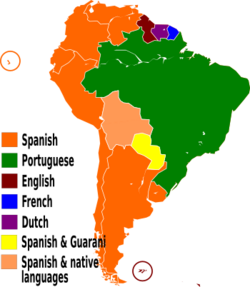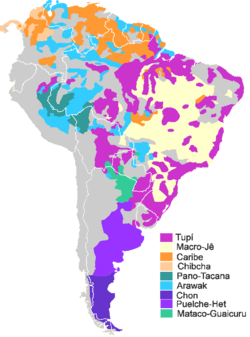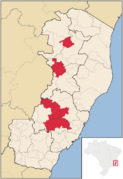Social:Languages of South America
The languages of South America can be divided into three broad groups:
- the languages of the (in most cases, former) colonial powers;
- many indigenous languages, some of which are co-official alongside the colonial languages;
- and various pockets of other languages spoken by immigrant populations.
Main languages
Spanish is the most spoken language of South America with Portuguese as a very close second.
Other official languages with substantial number of speakers are:
| Language | Speakers | Countries | Source |
|---|---|---|---|
| Spanish | 214,265,000 | Argentina , Bolivia, Chile , Colombia, Ecuador, Paraguay, Peru, Uruguay, Venezuela, Brazil | [1] |
| Portuguese | 211,754,600 | Brazil , Argentina , Paraguay, Uruguay, Venezuela | [2] |
| Quechua | 7,735,620 | Bolivia, Ecuador, Peru, Argentina , Chile , Colombia | [3] |
| English | 6,925,850 | Falkland Islands, Guyana, Colombia (San Andres y Providencia) | [4] |
| Guarani | 6,162,790 | Bolivia, Paraguay, Argentina , Brazil | [5] |
| Talian | 4,000,000 | Brazil | [6] |
| Hunsrik | 3,000,000 | Brazil , Argentina , Paraguay | [7] |
| Aymara | 1,677,100 | Bolivia, Peru, Chile | [8] |
| German | 1,285,800 | Argentina , Bolivia, Brazil , Chile , Paraguay, Peru, Uruguay | [9] |
| Italian | 1,259,900 | Argentina , Brazil , Uruguay, Venezuela | [10] |
| Dutch | 575,000 | Suriname | [11] |
| Japanese | 425,000 | Brazil | [12] |
| Wayuu | 416,000 | Colombia, Venezuela | [13] |
| French | 319,400 | French Guiana, Brazil (Amapá) | [14] |
| Sranan Tongo | 307,600 | Suriname, French Guiana | [15] |
| Pomeranian | 300,000 | Brazil | [16] |
| Mapudungun | 258,410 | Argentina , Chile | [17] |
| Caribbean Hindustani | 164,000 | Guyana, Suriname, French Guiana | [18] |
Indigenous languages
Indigenous languages of South America include, among several others, the Quechua languages in Bolivia, Ecuador, and Peru and to a lesser extent in Argentina , Chile , and Colombia; Guaraní in Paraguay and to a much lesser extent in Argentina and Bolivia; Aymara in Bolivia and Peru and to a lesser extent in Chile; Wayuu in northern Colombia and northwest Venezuela; and Mapudungun in small pockets of southern Chile and Argentina.
In Bolivia, three languages—Quechua, Aymara, and Tupi Guarani—are co-official alongside Spanish. In Paraguay, Guarani shares joint official status with Spanish. In Colombia, the languages of the country's ethnic groups are constitutionally recognized as official languages in their territories; more than 60 such aboriginal languages exist today. Ecuador uses Spanish, Northern Quechua, and Shuar as official languages for intercultural relations. In Peru, Quechua and Aymara, as well as other indigenous languages, are co-official in the areas where they are predominant. There are many other languages once spoken in South America that are extinct today (such as the extinct languages of the Marañón River basin).
In Brazil, there are around 135 indigenous languages confirmed. The regions with the most speakers are North and Central-West Brazil, where there is a larger concentration of native people. Indigenous populations have been trying to keep their traditions of their homeland, with the help of Funai, the agency responsible for the protection of the native people.
Rapa Nui is a Polynesian language spoken on Easter Island, Chile.[19]
| Language | Speakers | Countries | Source |
|---|---|---|---|
| Quechua | 7,735,620 | Bolivia, Ecuador, Peru, Argentina , Chile , Colombia | [3] |
| Guarani | 6,162,790 | Bolivia, Paraguay, Argentina , Brazil | [5] |
| Aymara | 1,677,100 | Bolivia, Peru, Chile | [8] |
| Wayuu | 416,000 | Colombia, Venezuela | [13] |
| Mapudungun | 258,410 | Argentina , Chile | [17] |
Classification
- Macro-Chibchan
- Chibchan
- Chibcha-Duit, Tunebo, Arhuaco, Cuna-Cueva, Guaymi-Dorasque, Talamanca, Rama-Guatuso
- Misumalpan, Paya, Xinca, Lenca
- Shiriana
- Paezan
- Choco, Cuaiquer, Andaki, Paez-Coconuco, Colorado-Cayapa, Warrau, Mura-Matanawi, Jirajira, Yunca, Atacameno, Itonama
- Chibchan
- Andean-Equatorial
- Andean
- Ona, Yahgan, Alacaluf, Tehuelche, Puelche, Araucanian
- Quechua, Aymara
- Zaparoan
- Omurano, Cabela
- Cahuapana
- Leco, Sec, Culle, Xibito-Cholon, Catacao, Colan
- Simacu
- Jibaro-Kandoshi, Esmeralda, Cofan, Yaruro
- Macro-Tucanoan
- Equatorial
- Andean
- Ge-Pano-Carib
- Macro-Gê
- Macro-Panoan
- Tacana-Pano, Moseten, Mataco, Lule, Vilela, Mascoy, Charrua, Guaycuru-Opaie
Source:[20]
Other non-indigenous languages
In Brazil, Italian and German dialects, specifically Talian, East Pomeranian, and Hunsrik, have co-official status alongside Portuguese in about a dozen cities and are mandatory subjects in schools in other municipalities. The states of Santa Catarina[37][38][39] and Rio Grande do Sul have Talian officially approved as a heritage language in these states,[40] and Espírito Santo has the East Pomeranian dialect,[41] along with the German language as cultural heritage.[41][42][43][44][45]
English is an official language in Guyana, and its creole form is the country's most widely spoken language. English is also the official language in the territories of the Falkland Islands (Spanish: Islas Malvinas) and South Georgia and the South Sandwich Islands.
French is the official language in French Guiana, an overseas region of France. Dutch is the official language in neighboring Suriname.
Italian is spoken by communities in Argentina, Uruguay, Venezuela, and Brazil.[10][46]
German is used by some in Brazil, Paraguay, Chile, Ecuador, Uruguay, Venezuela, and Colombia.[9][47]
Welsh is spoken and written in the historic towns of Trelew and Rawson in Argentine Patagonia.[48]
There are also small clusters of Japanese speakers in Brazil, Peru, and Bolivia (including Okinawans from the island of Okinawa). Brazil currently holds the largest Japanese community outside Japan.[49][12]
Caribbean Hindustani is spoken by the Indo-Guyanese and the Indo-Surinamese.[50] In Suriname, the language is known as Sarnami Hindoestani and is still widely spoken. However, in Guyana, where it is known as Aili Gaili,[51] the language is nearly extinct as a spoken language, with only words and phrases still remaining.[52]
Javanese is spoken by the Javanese Surinamese who form about 14% of the country's population.[53]
Sranan Tongo, an English-based creole, serves as one of the lingua francas of Suriname, alongside Dutch.[15]
Other non-indigenous languages spoken include Arabic,[54] Chinese,[55] Romani,[56] Haitian Creole,[57] Romanian,[58] Greek,[59] Polish,[60] Ukrainian,[61] and Russian.[62]
See also
- Languages in censuses
- Indigenous languages of South America
- List of unclassified languages of South America
- List of extinct languages of South America
- Extinct languages of the Marañón River basin
References
- ↑ Template:E23
- ↑ Template:E23
- ↑ 3.0 3.1 Template:E23
- ↑ Template:E23
- ↑ 5.0 5.1 Template:E23
- ↑ Template:E23
- ↑ Template:E23
- ↑ 8.0 8.1 Template:E23, Template:E23
- ↑ 9.0 9.1 Template:E23
- ↑ 10.0 10.1 Template:E23
- ↑ "Nederlands in het Caribisch gebied en Suriname" (in nl). Nederlandse Taalunie. 2022. https://taalunie.org/dossiers/22/nederlands-in-het-caribisch-gebied-en-suriname#:~:text=Nederlands%20in%20Suriname&text=Voor%20veel%20Surinamers%20is%20het,lid%20van%20de%20Nederlandse%20Taalunie..
- ↑ 12.0 12.1 Template:E23
- ↑ 13.0 13.1 Template:E23
- ↑ Template:E23
- ↑ 15.0 15.1 Template:E23
- ↑ Template:E23
- ↑ 17.0 17.1 Template:E23
- ↑ Template:E23
- ↑ Template:E23
- ↑ Greenberg, Joseph H. "The general classification of Central and South American languages", in: Men and cultures; selected papers of the 5th international congress of anthropological and ethnologicalsciences, Philadelphia, September 1956 PP. 791-4
- ↑ "Câmara Bento – Projeto do Executivo é aprovado e Talian se torna a língua co-oficial – Jornal Cidades da Serra". 24 September 2016. http://www.jornalcidadesdaserra.com.br/camara-bento-projeto-do-executivo-e-aprovado-e-talian-se-torna-a-lingua-co-oficial/.
- ↑ "Lei confirma o Talian como segunda língua oficial de Caxias do Sul". 30 March 2019. https://www.radiocaxias.com.br/portal/noticias/lei-confirma-o-talian-como-segunda-lingua-oficial-de-caxias-do-sul-81255.
- ↑ "Leouve - Talian é língua cooficial de Flores da Cunha". 15 June 2016. http://leouve.com.br/politica/serra-gaucha/item/55312-talian-%C3%A9-l%C3%ADngua-cooficial-de-flores-da-cunha.
- ↑ Lei Nº 1310 de 16 de outubro de 2015 - Dispõe sobre a cooficialização da língua do "talian", à língua portuguesa, no município de Nova Roma do Sul"
- ↑ O Talian agora é a língua co-oficial de Nova Roma do Sul, município de Nova Roma do Sul
- ↑ "Município de Serafina Corrêa Vereadores aprovam o talian como língua co-oficial do município". 30 March 2019. http://www.serafinacorrea.rs.gov.br/site/noticia/noticia_detalhe.php?gCdNoticia=406.
- ↑ 27.0 27.1 27.2 27.3 27.4 Espírito Santo investe na preservação da língua pomerana, in "Registros Escritos", fifth paragraph.
- ↑ "A escolarização entre descendentes pomeranos em Domingos Martins" (in pt). http://www.ce.ufes.br/educacaodocampo/down/cdrom2/pdf/texto18.pdf.
- ↑ 29.0 29.1 "A co-oficialização da língua pomerana (third paragraph)" (in pt). http://www.farese.edu.br/pages/artigos/pdf/ismael/A%20co-oficializa%C3%A7%C3%A3o%20da%20L%20Pomer.pdf.
- ↑ Município de Itarana participa de ações do Inventário da Língua Pomerana, Prefeitura Municipal de Itarana
- ↑ «Lei Municipal nº 1.195/2016 de Itarana/ES». itarana.es.gov.br
- ↑ "Pomerano!?" (in pt). http://lpniceia.wordpress.com/2008/12/27/pomerano/.
- ↑ "No Brasil, pomeranos buscam uma cultura que se perde" (in pt). http://gabeira.locaweb.com.br/causas/causa.asp?id=941&idSubd=40.
- ↑ "Lei dispõe sobre a cooficialização da língua pomerana no município de Santa maria de Jetibá, Estado do Espírito Santo" (in pt). http://www.ipol.org.br/imprimir.php?cod=604.
- ↑ 35.0 35.1 Cooficialização de línguas no Brasil: características, desdobramentos e desafios, third page.
- ↑ "Vila Pavão, Uma Pomerânia no norte do Espirito Santo" (in pt). http://www.secult.es.gov.br/?id=/aqui_tem_cultura/artigos/materia.php&cd_matia=1371.
- ↑ "LEI Nº 14.951" (in pt). http://server03.pge.sc.gov.br/LegislacaoEstadual/2009/014951-011-0-2009-001.htm.
- ↑ "Rotary apresenta ações na Câmara. FEIBEMO divulga cultura italiana" (in pt). 11 August 2011. http://www.cacador.net/portal/Noticias.aspx?cdNoticia=16388&cdNoticiaDivisao=2.
- ↑ "Fóruns sobre o Talian - Eventos comemoram os 134 anos da imigração italiana" (in pt). http://www.editorasaomiguel.com.br/correio/edicoes/reportagem.php?cod_rep=6071.
- ↑ "Aprovado projeto que declara o Talian como patrimônio do RS" (in pt). http://www.ipol.org.br/ler.php?cod=597.
- ↑ 41.0 41.1 "O povo pomerano no ES" (in pt). http://www.rog.com.br/claudiovereza2/mostraconteudos.asp?cod_conteudo=735.
- ↑ "Plenário aprova em segundo turno a PEC do patrimônio" (in pt). http://www.ipol.org.br/ler.php?cod=690.
- ↑ "Emenda Constitucional na Íntegra" (in pt). http://claudiovereza.files.wordpress.com/2011/06/pec-11-de-2009_1.pdf.
- ↑ "ALEES - PEC que trata do patrimônio cultural retorna ao Plenário" (in pt). http://www.revistajuridica.com.br/noticia_integra_new.asp?id=187110.
- ↑ "Pommern in Brasilien - LernCafe – Online-Journal zur allgemeinen Weiterbildung". https://www.lerncafe.de/aus-der-welt-1142/articles/pommern-in-brasilien.html.
- ↑ Bernasconi, Giulia (30 January 2012). "L'ITALIANO IN VENEZUELA". https://explore.openaire.eu/search/publication?articleId=doajarticles::e2c6e2d8ae5915079007d321c21defb0.
- ↑ "German, Colonia Tovar" (in en). https://www.ethnologue.com/language/GCT.
- ↑ Template:E23
- ↑ "Japan, Brazil mark a century of settlement, family ties | The Japan Times Online". 2008-01-15. http://www.japantimes.co.jp/text/nn20080115i1.html.
- ↑ Frawley, William (2003) (in en). International Encyclopedia of Linguistics: 4-Volume Set. Oxford University Press, USA. pp. 481–482. ISBN 978-0-19-513977-8. https://books.google.com/books?id=sl_dDVctycgC&q=caribbean+hindustani+165%2C600f%3Dfalse&pg=PA482.
- ↑ "Language" (in en-US). https://caribbeanhindustani.org/language/.
- ↑ "The Linguistic Legacy of Indian-Guyanese" (in en-US). 2014-04-21. https://www.stabroeknews.com/2014/04/21/features/in-the-diaspora/linguistic-legacy-indian-guyanese/.
- ↑ "Suriname - The World Factbook". https://www.cia.gov/the-world-factbook/countries/suriname/#people-and-society.
- ↑ Template:E23
- ↑ Template:E23
- ↑ Template:E23
- ↑ Template:E23
- ↑ Template:E23
- ↑ Template:E23
- ↑ Template:E23
- ↑ Template:E23
- ↑ Template:E23
External links
- Nicolai, Renato (2006). "Vocabulários e dicionários de línguas indígenas brasileiras". http://geocities.ws/indiosbr_nicolai/menu.html.
- Petrucci, Victor A. (2007). "Línguas Indígenas". https://www.oocities.org/indianlanguages_2000/index.html.
- South American Indigenous Language Structures
- SAPhon – South American Phonological Inventories
- Sound comparisons for various South American languages
- Diachronic Atlas of Comparative Linguistics (DiACL)
 |






